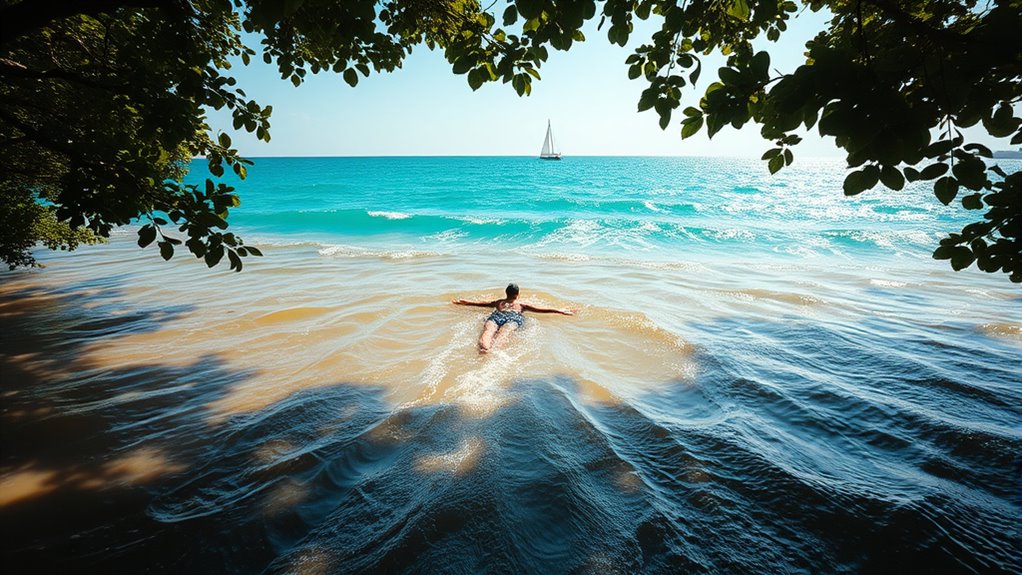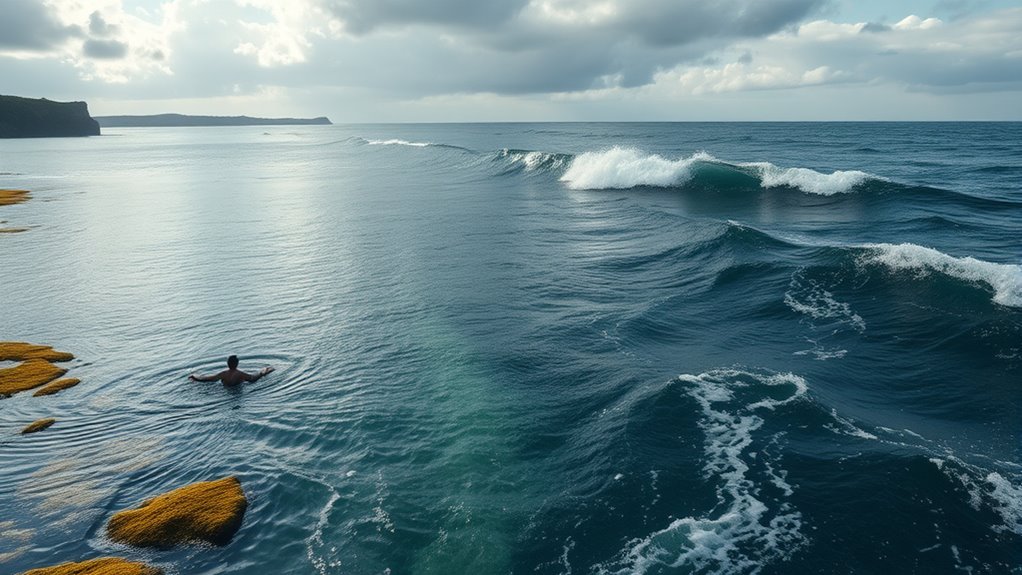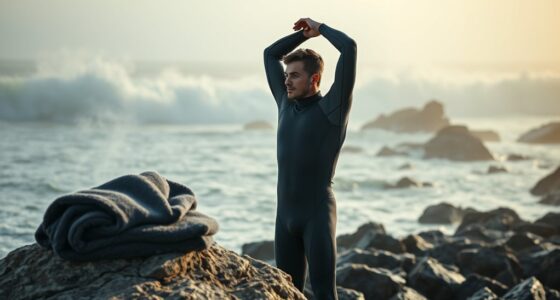Floating in rivers and seas involves different risks because of the environment’s flow and saltwater effects. In rivers, strong currents and obstacles like rapids or waterfalls can sweep you away or cause exhaustion, while saltwater in seas reduces buoyancy and can irritate your skin and eyes. Seas also bring unpredictable wave action and changing tides that can challenge safety. Understanding these differences helps you stay safe, and exploring further reveals how to better prepare for each environment.
Key Takeaways
- Rivers have steady, predictable flow; seas feature unpredictable currents influenced by tides and wind.
- Saltwater in seas reduces buoyancy and can cause skin or eye irritation; freshwater in rivers maintains consistent buoyancy.
- Rapid, strong currents in rivers pose risks of obstacles and exhaustion; seas’ wave action and gusts increase instability.
- Rivers often have controlled flow, but hazards like rapids and waterfalls require caution; seas demand vigilance against rough conditions.
- Both environments require awareness of natural forces, but seas generally involve higher unpredictability and environmental hazards.

Floating in rivers and seas offers distinct experiences, each shaped by their unique environments. When you’re drifting along a river, you’ll notice the influence of river currents—these flow in a single direction, often faster or slower depending on the river’s gradient and volume. River currents can be powerful, especially during heavy rains or in narrow channels, making your float unpredictable if you’re not cautious. You might feel the steady pull of the water, guiding you downstream, which can be both calming and risky. It’s essential to stay aware of the currents’ strength and direction because they can quickly carry you into obstacles or dangerous areas, especially near rapids or waterfalls. Rivers tend to be freshwater bodies, so saltwater effects aren’t a concern here, but the currents alone demand respect and attention.
In contrast, floating in seas introduces a different set of challenges and sensations. The saltwater effects are significant—they reduce your body’s buoyancy compared to freshwater, meaning you need to be more conscious of your flotation devices or swimming skills. Saltwater can also cause skin and eye irritation if you’re exposed for too long, and the salinity makes it more difficult to stay afloat without effort. Seas are influenced by tides, wind, and waves, which create a constantly changing environment. You might find yourself bobbing up and down or being pushed sideways by gusts of wind and rolling waves, which adds unpredictability to your experience. Unlike rivers, where the current generally flows in one direction, seas can have currents that swirl and change, making it harder to predict where you’ll end up. The saltwater effects, combined with these currents, mean you need to be more vigilant about safety, especially if you’re far from shore or in rough conditions.
Both environments demand respect, but they pose different risks. Rivers with strong currents can sweep you into hazards or cause exhaustion if you’re not careful. Seas with saltwater effects and unpredictable waves challenge your buoyancy and navigation skills. You’ll find that floating in a river often feels more controlled but still requires awareness of the water’s flow. On the other hand, floating in the sea can be exhilarating but also more dangerous if you underestimate the power of saltwater effects and the influence of tides and waves. No matter where you float, always prioritize safety, understand the environment you’re in, and respect the natural forces at play.
Frequently Asked Questions
What Safety Gear Is Recommended for River Versus Sea Floating?
When floating in rivers or seas, you should wear a life jacket for safety, regardless of the water type. In rivers, waterproof gear like dry bags and protective clothing helps keep your belongings dry and your body warm. For seas, consider adding a whistle or signaling device to your waterproof gear. Always check your safety equipment before entering the water, and choose gear suited to the specific environment.
How Does Water Temperature Differ Between Rivers and Seas?
Think of water temperature as the heartbeat of your floating experience. In rivers, thermal variations often follow seasonal changes, making the water cooler in spring and summer, warmer in fall and winter. Seas tend to have more stable temperatures, influenced by currents and larger bodies of water. You’ll notice rivers fluctuate more quickly, so plan accordingly, and always check local conditions to stay comfortable and safe while floating.
Are There Specific Signs of Rip Currents in the Ocean?
You should watch for rip current indicators like a narrow, calm, and flat area of water between breaking waves, often with a noticeable color change or debris moving seaward. Ocean rip signs include a line of foam, seaweed, or sand moving away from the shore, and a difference in wave patterns. If you spot these signs, stay calm, swim parallel to the shoreline, and avoid trying to swim against the current.
Can Floating in Rivers and Seas Be Done With Children Safely?
Sure, floating with kids can be safe—if you’re constantly supervising them and aware of water depth. Irony? Your best friend in water safety is vigilance, not just the floaties. Rivers can be unpredictable, and seas hide rip currents, so keep a close eye on your child’s position. Always choose calm, shallow spots, and never let your guard down; water safety’s a game of constant awareness.
What Are the Environmental Impacts of Floating in Rivers Versus Seas?
When you float in rivers or seas, you impact the environment differently. In rivers, pollution levels can harm delicate aquatic ecosystems, especially if waste or chemicals wash into the water. Seas, with their vast ecosystems, are more resilient but still suffer from plastic pollution and oil spills. Your floating activities can contribute to these issues, so always be mindful, avoid littering, and respect the environment to help protect aquatic ecosystems.
Conclusion
While floating in rivers and seas might seem similar, the risks differ markedly. Rivers often have strong currents and debris, increasing danger, whereas seas pose threats like waves and unpredictable weather. Some believe that floating in rivers is safer because of calmer waters, but studies suggest that the hidden currents and underwater obstacles can be just as hazardous. Always respect nature’s power, and remember that both environments require caution—trusting a myth over facts could be your downfall.










